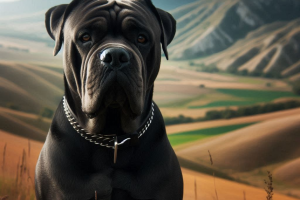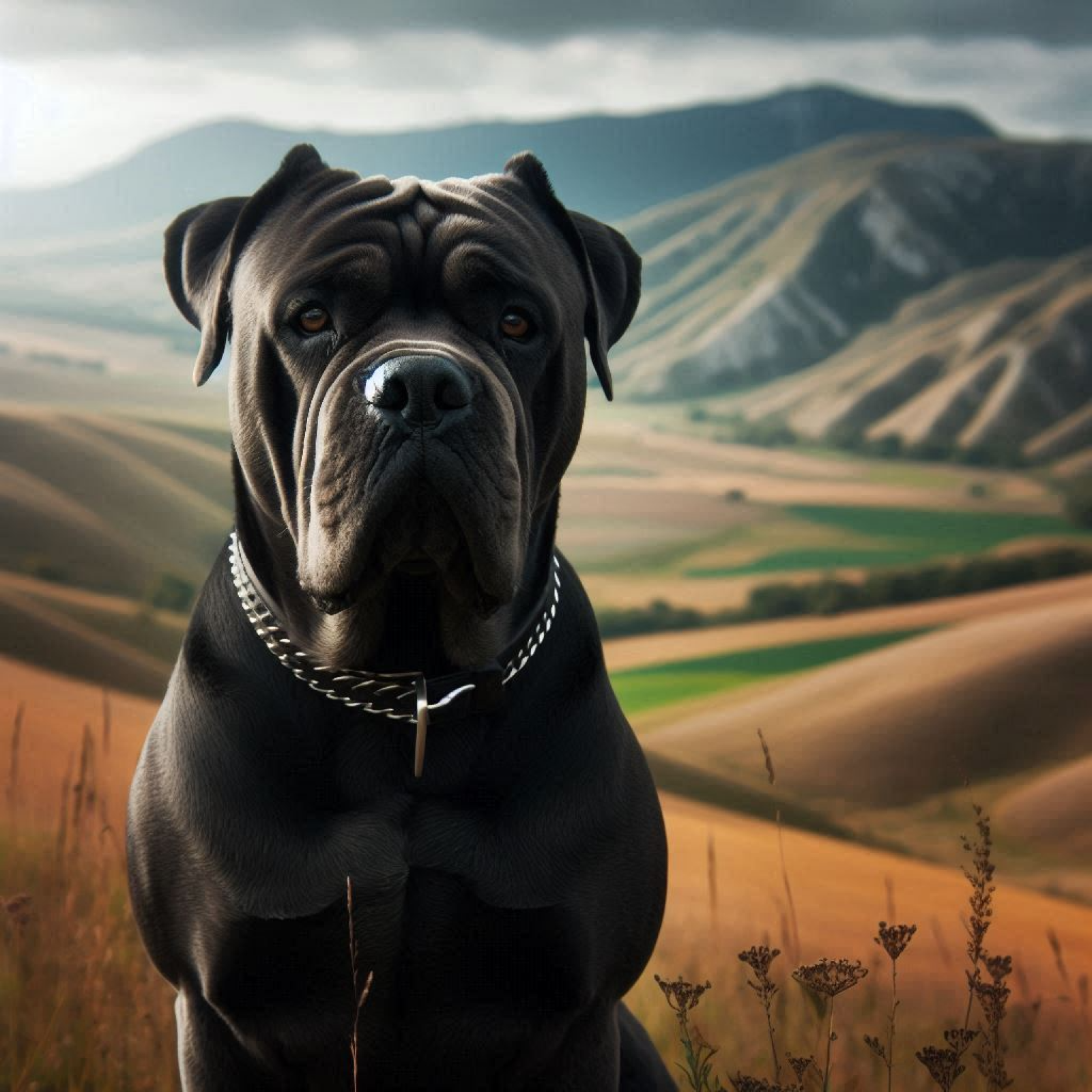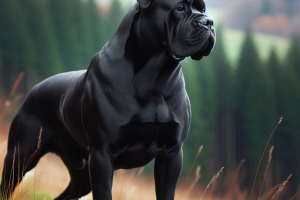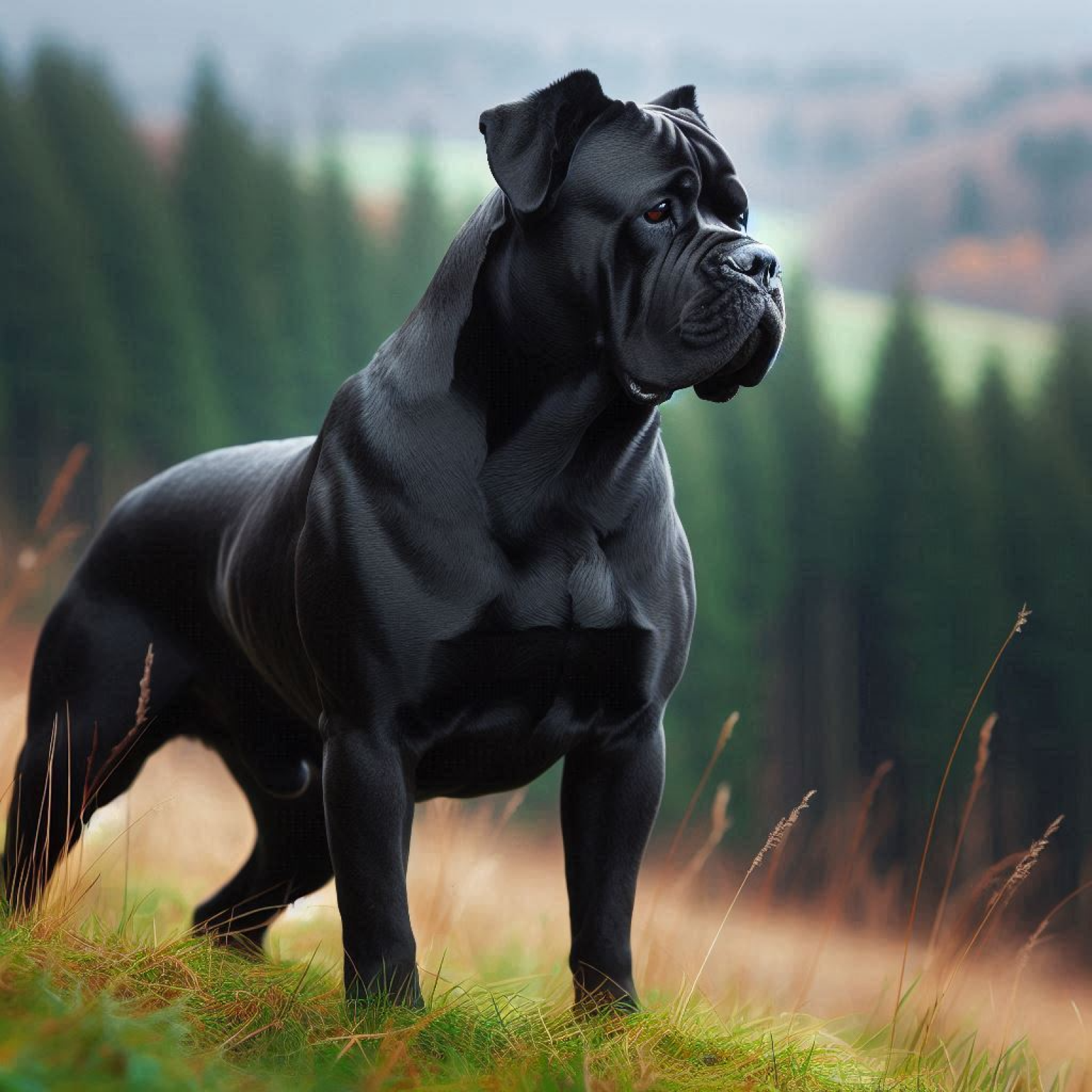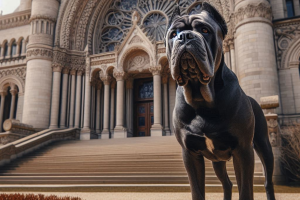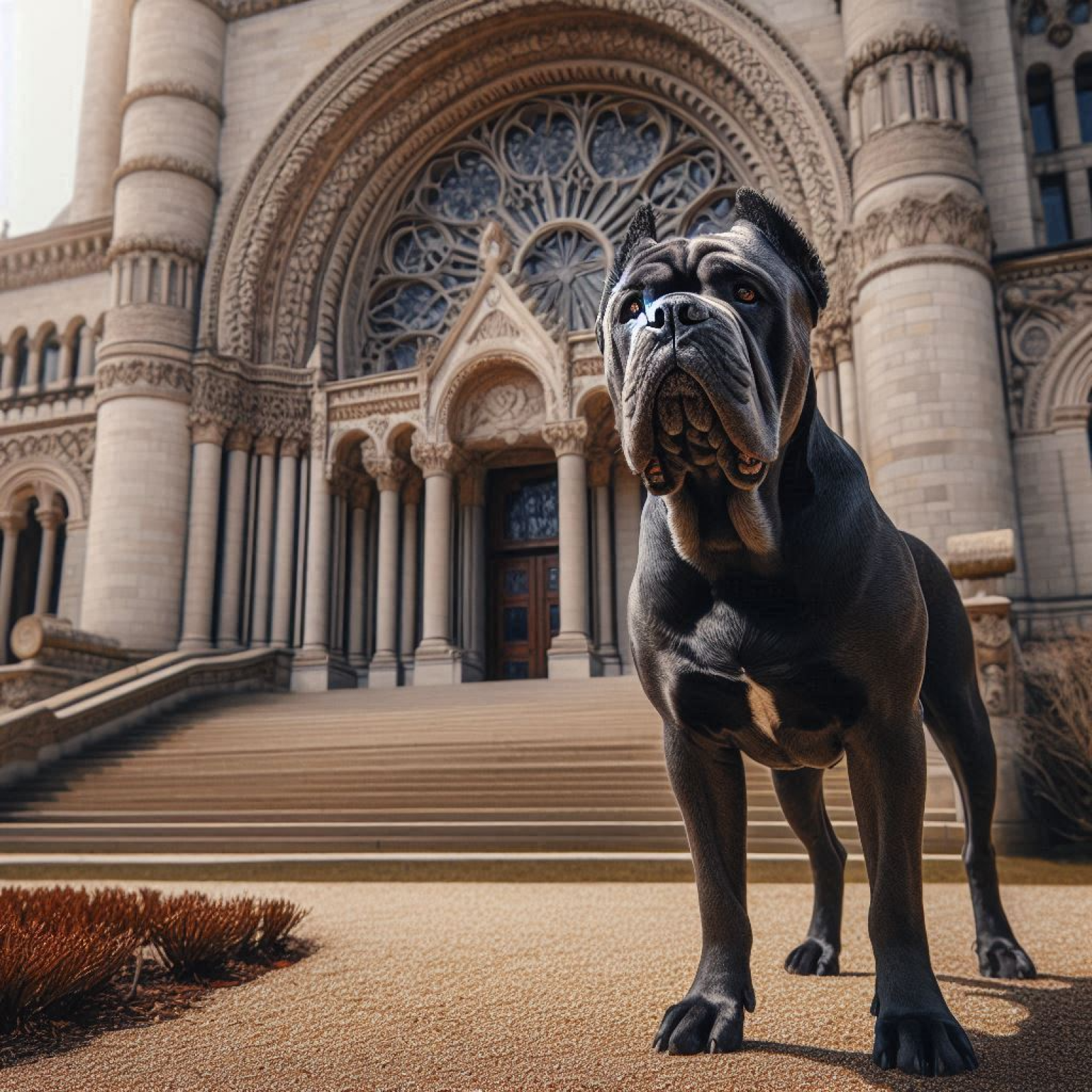Corso Puglia (Cane Corso Ortognato)
This is an article by the norwegian former Corso (Puglia strain) breeder Hactor Svelland, who claimes that todays Cane Corso is a mix of the rustic Cane Corso, crossbred with Napolitano mastiff X Boxer x Bordeuxdogue X Bullmastiff.
The only true Cane Corso left is the Corso Puglia, made out of 18 dogs by Paolo Breber, who left the breeding program in 1986, because the SACC (Sosietà Amatori Cane Corso) wanted to mix in other breeds, to make the Cane Corso breed faster growing, and earn some good money in the process, from the breeds newly revived popularity.
I`ve been in contact with Hactor Svelland recently, and he says that also the rustic Corso Puglia has been diluted as a breed, because of the same issue as the Cane Corso; popularity and greed after money. He has quit breeding the Corso Puglia, and says that it is hard to find a true rustic Corso working dog, and it`s also extremely hard to find an undiluted Corso Puglia. An Corso Puglia ( Paolo Breber`s strain) may after all not be a more rustic Corso than the Cane Corso, bred by SACC. That said I have friends that have a Cane Corso, who told me it`s the best watchdog they ever had. As I understand by talking to Hactor Svelland, the purebred Puglia strain with scissorsbite have been crossed back into the Cane Corso of SACC (Sosietà Amatori Cane Corso). Hactor has given up on the breed, because of the high percentage of HD plagued dogs, with no working abilities left. There ain`t any systematic HD checks through X- ray either, if there is no "suspicion" about it, which sounds a bit funny. According to Hector Svelland the once purebred Puglia strain of workingdogs are extinct. But here is his story about why the Corso breed went down and under, according to him.
Today Massimo Maschio is an italian breeder who only breed on scissorbite Corso`s, and not the type with an undershot. Massimo is a frontman for CICO, Club Italy Corso Ortognato, Corso`s with scissors bite, and he hosts dog-arrangements and tests.
According to Hactor Svelland, Massimo Maschio once had good dogs, but in the struggle of keeping the old Corso, when the world wants the new, he gave into the new "Corso", who by now often are HD plagued. Hactor Svelland still has radiographs and tests of several dogs that proves his contention.
History
The situation of the rustic Cane Corso dog was very alarming in the 70`s, and threatened the breeds existence. The breed was at the time not welcome among other dog enthusiasts, and was reduced to a very low number of individuals, despite the efforts by Bonatti and Prof. Ballotta, who tried to revive the breed.
It was in 1976 that the enthusiastic dog lover, professor and researcher in Italian tradition, Paolo Breber, got attention for the breed when he published an article in ENCI`s (the Italian Kennel Club) magazine.
The first thing he did was to initiate a rescue operation, which was conducted by him and some other enthusiasts who had made contact with him after they had read his article. Some of these were from the already established dog environment with other FCI Molosser type breeds.
In 1983 they founded SACC. (Sosietà Amatori Cane Corso). Safeguarding properties and rescue of the breed was this organization's primary purpose. This group got a bit of a shock in October 1986, when Paolo Breber left SACC.
There were several reasons why it happened. I have personally spoken with Paolo Breber on several occasions. We have eaten dinner together several times and we have had plenty of time to discuss Corso`s, and I've gotten confirmations about why he did as he did in 1986.
The true explanation follows here.
Paolo Breber left the group because of the group's intentions to destroy the breed rather than to protect and save it. Paolo Breber had clear intentions about how the reconstruction could be done, but was met with other challenges that he would not be involved in conducting. There was input from members of the group to cross other breeds into the existing individuals who made it impossible for him to stay. If other breeds was mixed into the Corso, then the breed would be destroyed immediately. So Paolo Breber left the building.
Paolo Breber had 18 Corso`s in his kennel. These dogs he had chosen from different areas in Puglia, Calabria and Bari. Common to all of them was that they had characteristics that the Corso should have, and they were fairly equal being same type in characteristics and appearance. It was not possible to find very type like, or uniformed Corsos. Different areas of use and different origins of the Corso dogs explains the difference in it`s appearance. Breber knew little about the background of the breed, except from what the farmers told him. His first litter was from the bitch Tipsy and the stud dog Dauno. The offspring Basir became the model for the breed`s standard in 1980.
Through selective breeding Paolo Breber wanted to reconstruct the breed, but then the conflict started towards those who would exploit the breeds characteristics and public revived popularity, for their own benefit.
After this Paolo Breber left SACC, and he then concentrated mostly on his own kennel in Mantova with help from Giancarlo Malavasi, towards the entire breeding program to revive the breed. The management of SACC was at the time Stefano Gandolfi, Giantonio Sereni and Fernando Casolino.
Then the fatal decision was made after a while. The breeding program had to be accelerated at any costs inside of the SACC. The planned breeding that Paolo Breber envisaged in SACC, was not followed. SACC did what they could to achieve and gain wherever they could win the most. A long-term breeding program takes time, and SACC did obviously not have that. So it was prepared a written document by Dr. Antonio Morsiani, who at the time was sitting in the Judge Committee in ENCI in 1987.
In the same release (of the ENCI magazine) where the standard was published, SACC applied for the breeds approval from ENCI, and the document ( with the breed standard) said that the Cane Corso should stand out from the other Italian Molosser, the Mastino Napolitano. One of the main differences should be the bite. Great confusion was the result of it (the bite), and still is. To achieve this bite, light pragnathism was required, which is a slightly undershot jowl. Pincher bite was tolerated, although it (pinchersbite) and scissorsbite (Ortognato) were more common (than the slightly undershot jowl- pragnathism).
This is not only confirmed by Paulo Breber and the first enthusiasts and breeders, but it is also confirmed in the books of the first official Convention. (collection), Convegno nazionale di Civitella Affadena of June 16, 1990.
In 1992, for easier to follow the development of the breed, ENCI decided registering births of Corso`s by parents who had been judged and approved by judges in the show ring.
This led to a stream of (new) blood lines and different types of Corso`s. Many were not purebred either. Anyone could show off a dog as a Cane Corso. I write Cane Corso here because it was what was to be the new name that the breed should be declared under. Anything could be a Corso. and yes, it was clean purebred Corso`s from Puglia too, most often with a scissors bite, also called Ortognato.
But there were many mixed dogs, and individuals who had nothing to do with the Corso at all. An exhibition judge only demanded a 1.AK from the Cane Corso for enrollment in ENCI`s register. That`s a red ribbon from one who might not have the greater understanding and knowledge of this breed at all. The breed was, after all, relatively unknown to ENCI`s judges at that time.
All this was recorded into an unofficial registry called the Libro Apperto, or open book. Data from this registry was continued into official registers, when the breed got it`s approval from the ENCI on the January 20th, 1994. The lack of enthusiasm for the breed within the SACC for how it was supposed to be bred, along with no proper responsibility taken, the lies and the fully awareness of the fact that it was crossed several breeds into the Corso, to increase the number of individuals before the breed got its approval from ENCI, SACC should be entirely blamed for.
There was an uncontrollable increase of Corso litters, and as a consequence, a decline in the average quality of the offspring occurred. Neither now SACC did take any form of self-criticism, and never really tried to do something about the issue while they still could, but instead they put the wind into their sails and used every opportunity to publicize the breed, highlighting themselves as the breeds rescuers and protectors. In this way, a few tens of puppies a year grew too quickly 2500. Political aspects of modern Corso history has led to so much tragedy, as the Cane Corso are still struggling caused by the aftermath of this today, and will do so forever.
Boris.
In 1996 CH Boris was used as a model for the implementation of the breed characteristics and appearance. Boris was a small dog with a stumped tail if you ask me. I'm not saying that there were no qualities in Boris, because it definitely was. He just was not the ideal by any means.
A few months later the same year Cane Corso was recognized at the international level by FCI. SACC and ENCI, and all though this seemed like a positive result for the breed, but it only lead to further worsening of the system, because of many enthusiast from outside of Italy, inspired by the novelty of the situation, bought the Corso without due care or consideration. Often their choice was based on lack of information, the availability, the color or the price of the puppies.
This is by all means an harsh start for new breeders, and what has clearly been undisclosed during the latter years, are as said above, the total lack of serious management of information, to ensure a race at the highest international level. In the total confusion around the Corso, the mixed in dogs and the breed standard, the few enthusiasts who started out with the project and the reconstruction of the Corso, have till this day not been able to make any form of contact with ENCI through SACC, who hide their shortcuts and shortcomings as well as they can, behind a wall of ignorance.
So, in July of 1999, after years of poor leadership and clutter, SACC was deprived of the title as the official Cane Corso club. In an attempt to get out of this situation, some new fans, as they call themselves, have started AICC. There is a dark cloud hanging over the AICC, and they build on the same story as SACC. I decline to write the names of relevance in this context. It has no or little meaning, but that it involves farmers who are veterinarians, and ring-judges who have a great influence towards the breed, is thus said.
Basir
Basir was a good dog, with many good qualities. Basir had an undershot with contact. (pragnathism). Therefore, it was also written pragnathism as desirable in the standard. The majority in litters after Basir had not undershot. Undershot should not be defined in the standard, because most Corso`s had scissors bites (ortognato) in the eyes of Paulo Breber. The standard should be; scissors bite, pincher bite, or an undershot bite with contact (slightly pragnathism). As long as the bite is like one of these three former mentioned, it`s the correct bite!
Many Cane Corsi are currently seen with an undershot, as the English bulldog and the Dogue de Bordeaux. Although the head shape looks like a scoop on the Cane Corso of today, there still are, unfortunately, breeders that breed to especially get this particular head shape.
There was born some litters through Paolo Breber`s hands, but after a short time, several individuals from him were infected with blood from other diluted Corsi through SACC. The mentality changed together with the crossbreedings that were made. Malavasi had some good Corsi at his early times and he started out with many good dogs. The Cerberus line from him has left traces. It is almost possible to recognize a Cerberus dog because many of them looks similar in type as appropriate Corsi of old. But gradually also he began to change his type and the appearance of his dogs.
That money changes the world also applies in the dog world. Most people today are buying puppys uncritical and unaware of the fact that an exhibition champion dog, does not necessarily mean that it is a good or proper Corso they have in front of them. There exists clear evidence of that it was used Boxer, Bullmastiff, Dogue de Bordeaux, Rottweiler, and Mastino Napolitano in reviving, or should I say, in the "reconstruction" of the Corso breed. Believe it or not. It's the truth!
It's done a lot in the time of the modern Corso that breeders of this race should be ashamed of. It has been put together so much different Corso`s, that it's almost become impossible to know for sure what lies behind the breed. Closely related specimens used in combinations (inbreeding), even Boxer crossed with Mastino Napolitano has been sold as the "true" Cane Corso. This breed has become so popular in a short period of time, that all too many saw their chance to get a piece of the pie while they still could.
The shortcuts to recognition from ENCI and the FCI`s approval of Corso was done this way. There were even some Corso`s of the correct type and without any interference of other races, but these were less desirable, because they were not satisfying of the SACC new goals and ENCI`s breeding standard (undershot jowl-pragnathtism). A rustic Corso is hard to find today, and has quite a high value. Some enthusiasts are still looking almost every day round in Puglia in Italy to find one of these. So do not say that to popularize the breed was not a big mistake.
Today, it is born annually about 3500 Cane Corso`s in Italy. You don`t have to be a professor of mathematics to understand that it is not possible to achieve these numbers in such a short period of time, while still breeding a pure line / strain.
It is born some undiluted Corso litters of today, too. But these are bred by more selective breeders with enthusiasm in what they do. But there are not many breeders like this left.
There still exist literature from the 80`s, and it`s almost unbelievable that it`s the same race we look upon through the pictures. The older pictures clearly show typical features. Not many had round heads and the undershot like many Corso`s have today.
How do we explain it? The answer is obvious.
I've been quite a few times in Italy. I've probably been there about 50 times. I have visited many breeders. I have also imported several Corso`s to Norway, more than anyone else has. I was besides a single Swedish import the first one that had a Corso in Scandinavia. Today there are unfortunately too many breeders here in Norway. I have spoken with more breeders than anyone else I know, in general. I know the truth and a lot of background of what we now call the Cane Corso. It also applies to several of them dogs who through others have found their way to Scandinavia as exhibition dogs. There are many who have admitted what has been done to the Corso breed.
Things have gone so entirely wrong that it is almost impossible to trust anyone anymore. There are stories on stories, but nothing are being admitted publicly by breeders of the race. There are fake HD diagnoses and fake studbooks. It's only the money that matters to so many, no matter what they are trying to get others into believing.
Thanks to Paolo Breber some of us may still rejoice over the Corso`s who still can be associated with the old gladiator dog, the guardian, and the multipurpose dog from the Puglian history. Breber would have a practical standard of utility. He wanted to have mental tests of the dogs used for breeding, practical tests, and more added to it.
The Corso is no show dog! It is, and has always been, a working dog. It should be used for what it has the ability to do. Fortunately it is not everyone who has the Cane Corso which really has a Corso - if you know what I mean. You know what a Corso is when you have a; Corso Pugliese.
This type of Corso`s is the right original Corso without the dilution of other races in modern times. It is developed through a selective breeding program, (as well as it can be done), on individuals with ancestry from the Puglia region.
This is the Corso which Paolo Breber started out with, and which he would develop based solely on Ortognato (scissorsbite) individuals. CICO is the club that works to protect the characteristic Corso dog, through tests, collections, and with Paulo Breber as the former president, started by Massimo Maschio. All the material from Breber are credited, and is available at this club. Old unpublished photos and stories that are important in the breed's recent history can be found here.
Massimo Mascio is a frontman for CICO and hosts dog-arrangements and tests. He breeds solely on functional Ortognato individuals, with a well documented history.
CNCO is Club Norway Corso Ortognato. Based on philosophy of Paulo Breber and Massimo Maschio. We will do what we can to tell people the truth, showing through training what a Corso really are, and breed the best individuals of the raceclub availeable.
And we dont breed Corso`s as exhibition dogs.
Translated from norwegian into english by eivohan -aka- Eivind Ottar Hanssen.
If anyone wants to contact Hactor Svelland for any clarification, his mail are: ha-svel@online.no
OLDER HISTORY
GOOGLE TRANSLATION from nowegian. Article by Hactor Svelland
When the Holy Spirit falls on me, and I get inspired, I`ll do a proper translation ;)
Cane Corso
It is important that we know the truth about a race history. History of Corso is in so many cases misleading and at times based on outright lies. We must know the truth us who want the best for the breed, and love it for what it is of old.
It is described as very inconsistent and it is simply not true all that described most seats in websites, books, and the like. There are of course several reasons why this is so sadly.
It is easy to copy the story from others who have described it. Is this error described becomes uncritically relayed by people who can not story to others who also want to get the truth.
Some simply want it to be that they themselves have described. There are several reasons, but one of them is that it suits them best even so. It must be possible to have some judgment itself, and ensure bit before sticking in hop something that others recounting further (Elaborates this claim later). Here you can at least read what is true, from people who know the story, which otherwise about Corsi on this page.
The history of the breed I want to share in ancient history and recent history. The whole story is important for those who are interested in the breed. The Corso (canecorso - ka-ne-chorus-soh) which we can admire today is built on direct development of the story, without admixtures of other races, and has characteristics that define them as Corsi.
The description of the history of Corsi will be long if I should take the most. I've shortened it down to what is most essential.
ancient history
Corso = singular
Corsi = plural of Corso
Pronounced core soh
First I will say to you who are wondering why I am writing Corsi, that it is Corso and Corsi that is the correct name of the breed. Cane means dog. We all know that there is no horse or bird we're talking about here, so we stick only to Corso. Some disturbances it's only around the name of the breed. Some do not know the name of their own race. Some call it Kane, others Kein Korsö and more.get agrip.
History of Corsi has evolved over hundreds of years along with the Italian people. Corso is a very old type of use dog that has roots back to the oldest Molossers which was introduced to Europe. Corso is not a new breed.
Corsi was most prevalent in southern areas up to Rome. Specifically Puglia region but also in Naples and Bari. Traditionally classified under Cane e presa name. In Puglia region went this type of dog, also called Corso Pugliese.
Although the breed is now reconstructed in recent years of very few enthusiasts, there's plenty of evidence and background material describing breed applications through drawings, sculptures and stories back several thousand years.
Corsi is a classic Molosse. (Not Mastiff). Corsi stems from Alaunts type Molosser.
The name Corso still have a little uncertain significance. The most trusted and oldest documentation is as follows and is also found in poetry and prose. The name derives from Greece and Latin. The Greek name means KORTOS wall, and from Latin Cohors meaning guardian of reason and farm.
It actually means that Corso is a farm dog in ancient significance and one of its tasks has clearly been a guard dog for farmers who also needed a protector for himself, his family, livestock and the like. Another important job Corsi did the farmer was its forward transferor job as a butcher dog. Being able to drive, chase in, stick bulls and cattle was a prerequisite.
Cane Macellaio is a name that has also been used exclusively refers to the job as a butcher dog and guard - not a special breed.
Corsi through a large part of the story also been used as war dogs. There is much dukumentasjon it. The military use of Corso was so widespread that there were large and many kennels only bred war dogs. Found in Monopoli di Sabina scroll (near Rome) from 1137 shows a clear link between Corsi and Roman history.
Corsi was besides being guarding dogs and war dogs, also very good hunting dogs on larger animals. There are some who believe that this was the largest application to breed, but the story does not prove it. However proves it that it has been used as is. Especially as a fast tracker big game items boar. Before these dogs were defined as Corsi and use of Corsi was widespread in Italy, Alaunts type moloss used as hunting and war dogs across Central Asia. Also in Europe from the introduction hereto.
The use of Corsi was summarized as cattle drover, butcher dog, bloodhound and hound big game, battle and war dog, and certainly for personal protection.
Through reading Italian history are strong ties between Corsi and civilization from the time, and until today. We can allow us to say that the breed has existed for a few thousand years as Corsi. The principal evidence of that is that the properties Corsi had (some have even) using dogs for centuries can take us so far back in time. It was the use of such properties rather than someone at the time.
Corsi has existed through the fascinating civilization of the past, the structure and the fall of the Roman Empire, the Middle Ages and in modern times. Corsi has survived through natural selection through time, in close consultation as possible with the environment, and in the roles man had use for their valuable dogs. We are talking about hard times when the success and survival of Corsi was dependent solely on their ability to work. The choice of nurturing and keeping dog was only for the use of their properties.
Corsi has safeguarded properties from their ancestors Molosser of Epirus, and Canis pugnax from Rome. Exclusively Roman fighting dogs, gladiator dogs and war dogs of amusements in Colosseum. Aggressive and combative by nature was a necessity to achieve the goal that was without hesitation to attack with a surprising and potent force ..
Through contact with humans as required for use as a working dog, the breed has evolved to become more adaptable and applicable. Especially in rural provinces south of Italy where they have long maintained an older system in agriculture, where a multitude of uses is a synonym with a perfect and important partner.
Corso is not of Corsica as some missinformerte mean.
Corso is not the same as Neapolitan Mastiff, although it is much similar genetic historical background until the 70s where this breed went under and if you ask me. In Mastino Napolitano today it St.Bernardhund and English Mastiff, and certainly not many pedigrees can rely on there either. The old Mastino Napolitano is very nearby a Corsican. Because of selection for different applications purpose the two types of the same ancestors bred differently. The old Mastino Napolitano is alleged extinct, and traces of it can be found through some types Corso.
Corso has nothing Sicilian mastiff to do that unfortunately being used as another name. This is erroneous. Even in dog books and on many breeders website. Honestly folks. Should Corso have long fur and white color now? No. Sicilian Mastiff is a separate breed.
Corso is not a reconstruction of the Branchiero Siciliano still detracts.
Corso is not Bucciriscu Calabrese, Dogo Dogo Sardo or Siciliano. Why mention of these other breeds? There are even more ...
Several of them have significance for Corso history. There are many breeds that were used for the same purposes different places in Italy. Several of them are very similar, and all have some similarities as Corsi. Some of them have been guaranteed junction with Corsi of old, in the belief that it was the same type of dog. There is no doubt det.Ingen dog was bred in the past just because appearance. They were produced for a purpose. There were several types of Cane e Presa type dog that did the same type of job. Cane e Presa type of dog means dog that bites. It could be defined in several directions, but the ad used the jaws of something must be imaginable.
Before was a dog defined according to what it did, not how it looked. A good cattle driver and butcher dog may very well have been a Branchiero or Bucciriscu Calabrese as Corso. All of them have a lot in common in genetic background and uses, so we have self esteem assume any blood from them are in Corsi. There are many proofs that all Tryp of the Cane e Presa named group dog have the same origin. Alano Espanol, Presa Canario, also related background but different development.
Sources of information can be found in several books and magazines. The best information is the information you`ll everget will be told from breeders and farmers of a bit of age, who really used their dogs. Some are straight true breeders of undiluted Corso`s, but there are not many left. Remember that it is a poor life in many agricultural areas in Italy. Many will do very much for the sake of money, and many people with that sort of attitude have taken advantage of others, and have exploited and cheated unknowing persons, selling them mixed Corso`s.
Several disturbances around this stately Molosser is the last thing the Corsi breed needs, and this page shall not be the cause to any more of them.



